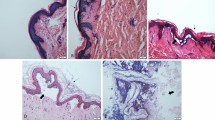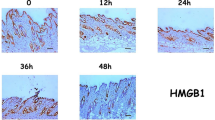Abstract
This study demonstrates post-mortem autolytic alterations in the skin at cellular and subcellular levels and identifies parameters which may assist in determining the time of death in the first few hours post-mortem. Serial skin samples from the ventral surface of the arm were taken at intervals of 3, 6, 9 and 12 h after death in 29 subjects of various ages, with no signs of skin disease; causes of death were various. Three types of tests were performed: cytochemical (hematoxylin-eosin and alcian-PAS), immunohistochemical (S-100, CEA, Cytokeratin, ASM) and ultrastructural (electron microscopy). Electron microscopy proved useful for identifying transformations which were found to be specific for each chronological step considered: reduction of intracellular glycogen in clear cells and reduction of secretory granules in dark cells are typcial signs of the first stage (3 h) after death; mitochondrial dilatation and rarefaction of cristae in clear and dark cells are typical of the second stage (6 h); rarefaction of microvilli in dark and clear cells is a sign of the last stage (12 h). Cytochemistry and immunohistochemistry supply useful information — not for all the chronological stage considered here, but for individual phases (3 h for hematoxylin-eosin and 6 h for alcian-PAS). However, it is particularly important to use the results from all such techniques simultaneously, so that the question of the exact time of death within the first 12 h post-mortem may be more accurately answered.
Zusammenfassung
Diese Untersuchung zeigt postmortale autolytische Veränderungen in der Haut auf zellulärer und subzellulärer Ebene und identifiziert Parameter, welche helfen können, die Zeit des Todes in den ersten Stunden postmortem zu bestimmen. Hautproben von der Beugeseite des Arms wurden, 3, 6, 9 und 12. Stunden nach dem Tode von insgesamt 29 Leichen entnommen (verschiedene Altersklassen, keine Zeichen für Hauterkrankungen, verschiedene Todesursachen). Drei Arten der Untersuchungen wurden durchgeführt: zytochemisch (Hematoxylin-Eosin and Alcian-PAS), immunhistochemisch (S-100, CEA, Cytokeratin, ASM) und ultrastrukturell (Elektronenmikroskopie). Die Elektronenmikroskopie erwies sich als nützlich für die Identifizierung von Transformationen die für jeden chronologischen Schritt spezifisch waren: Reduktion des intrazellulären Glykogens in hellen Zellen und Reduktion der sekretorischen Granula in dunklen Zellen sind typische Zeichen für die erste Phase (3 Stunden) nach dem Tode; mitochondriale Dilatation und Rarifizierung der Cristae in hellen und dunklen Zellen sind typisch für die 2. Phase (6 Stunden); Rarifizierung der Microvilli in dunklen und hellen Zellen sind typisch für die 3. Phase (9 Stunden) und Kernpyknose von dunklen und hellen Zellen ist ein Zeichen der letzten Phase (12 Stunden). Zytochemie und Immunhistochemie sorgen für eine nützliche Information — dies gilt nicht für alle chronologischen Stadien, welche hier einbezogen wurden, aber für individuelle Phasen (3 Stunden für Hematoxylin-Eosin und 6 Stunden für Alcian-PAS). Es ist jedoch besonders wichtig, die Resultate von allen solchen Techniken simultan einzubeziehen, so daß die Frage der exakten Todeszeit innerhalb der ersten 12 Stunden postmortem genauer beantwortet werden kann.
Similar content being viewed by others
References
Coe JI (1993) Postmortem chemistry update. Emphasis on forensic applications. Am J Forensic Med Pathol 14:91–117
Fisher RS (1980) Time of death and changes after death — Anatomical considerations. In: Spitz WU, Fisher RS (eds) Medicolegal investigation of death. Charles C Thomas, Springfield, pp 12–32
Janssen W (1984) Forensic histopathology. Springer, Berlin, pp 24–25
Balercia G, Cingolani M, Cinti S, Sabattani PG, Tagliabracci A (1986) Alterazioni ultrastrutturali postmortali della cute e cronologia della morte. Medicina Legale Oggi — Atti XXIX Congresso S. I.M.L.A. Cepi, Roma, p 21
Cangiotti AM, Morroni M, Tagliabracci A, Cingolani M (1986) Aspetti ultrastrutturali delle ghiandole sudoripare eccrine umane normali nel giovane e nell'anziano. Riv It Biol Med 6:148–151
Sato K (1977) The physiology, pharmacology and biochemistry of the eccrine sweat gland. Rev Physiol Biochem Pharmacol 79:51–129
Sato K, Sato F (1983) Individual variations in structure and function of human eccrine sweat gland. Am J Physiol 245: 203–208
Weiss L (1988) Cell and tissue biology. Urban & Schwarzenberg, Baltimore, pp 96–102
Sato K, Sato F (1990) Methods for studying eccrine sweat gland function in vivo and in vitro. Methods Enzymol 192: 583–587
Sterberger LA (1979) Immunocytochemistry. John Wiley, New York, pp 104–157
De Lellis RA (1981) Diagnostic immunohistochemistry. Masson, New York, pp 50–52
Bijman J (1987) Transport processes in the eccrine sweat gland. Kidney Int 32:109–112
Bernheim P, Willot M, Muller P (1966) Quelques aspects de l'autolyse du muscle strié humain au microscope optique et électronique. Ann Méd Lég 46:447–452
Suzuky T (1976) An ultramicroscopic study on rigor mortis. Forensic Sci Int 8:207–216
Author information
Authors and Affiliations
Rights and permissions
About this article
Cite this article
Cingolani, M., Osculati, A., Tombolini, A. et al. Morphology of sweat glands in determining time of death. Int J Leg Med 107, 132–140 (1994). https://doi.org/10.1007/BF01225600
Revised:
Issue Date:
DOI: https://doi.org/10.1007/BF01225600




